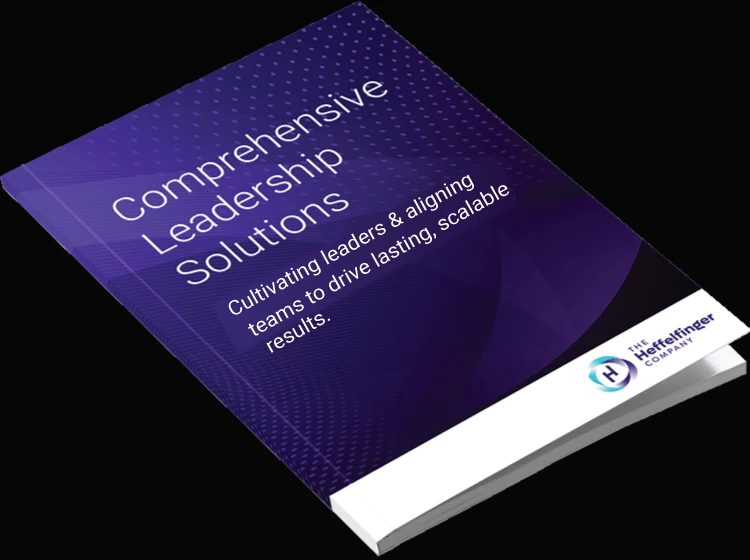“The improvisational ability to lead adaptively relies on responding to the present situation rather than importing the past into the present and laying it on the current situation like an imperfect template.”
~ Ronald A. Heifetz
Introduction
In our last blog, we talked about Adaptive Leadership as the ONLY form of leadership that will be successful going forward. If we want to remain relevant and impactful as leaders, we must be able to respond appropriately to shorter change cycles and increasing complexity. We must both sense and respond with fresh eyes to what is happening in our internal and external environments.
The case for being adaptable is clear. The question is, do we as leaders know how to build our adaptation capability? Even those of us who love leading or facilitating change struggle. We may say to ourselves: I’ve already learned and changed so much – I just want to leverage all that growth and experience and practice what I know works well.
If you want to be successful, you need to evolve. You either change and survive or you “die” in your comfort zone.
~ Robert Quinn
The case for Individual Leadership Change is also clear; if, as a leader, you resist transformation, the gap between your company and the rest of the world will swallow you both in the end.
2020 created an increasing awareness that we live in a world of dynamic non-equilibrium – a constant state of flux – where our internal and external conditions are never quite the same from day to day and where changes we face are not moving us toward some ‘new state’ of stability, order, predictability, or equilibrium. Everywhere we look, we realize leadership – our leadership – is required.
So, how did we get here? Or where do we go from here? We will shed light on this by revisiting a framework we introduced in an earlier post (Building Adaptability as a Capability) called the Adaptive Cycle of Development and discuss how it applies to our Individual Leadership.
Reinventing Ourselves as Adaptive Leaders
To reinvent ourselves as adaptive leaders, we look to the Adaptive Cycle of Development – which illustrates how leaders (living systems) move through four natural stages of growth and development: Inventing, Innovating, Maturing, and Releasing. We use this tool to help navigate the natural change cycle to enhance our impact and effectiveness.
The Adaptive Cycle of Development
- As leaders, we continuously create ourselves, which requires adapting to both our internal and external environments (Innovating => Maturing)
- At some point, we experience a growing dissonance between our leadership style and what we, our organization, our industry ask of us. (Maturing => Releasing)
- Releasing involves shedding what no longer serves, rejecting what never served, and breaking down old forms and constructs to make space for new thoughts and ways of being and leading. To determine what we need to release, we must live through the discomfort of dissonance, resisting the urge for quick fixes. (Releasing => Reinventing)
- We now need to reinvent ourselves as leaders. Having released old ways of being and leading, we have the space to invent new strategies and begin innovating. (Reinventing => Innovating)
Let’s walk through each part of the Cycle as it applies to individual leadership, starting with Maturing.
MATURING:
At the beginning of 2020, many of us were at some stage of “mature” leadership. Especially if we were in relatively stable jobs, organizations, or industries. We knew what we were doing. We may have been primarily internally focused on internal controls and standards (finances, metrics, quality measures, performance standards, internal processes).
As Leaders, we helped our organizations scale by creating systems and processes. And even good leaders can become overly internally focused (ex: budget meetings, status meetings, project reviews, performance reviews, oversight, and approval processes). Additionally, as leaders, we may have become overly dependent on our “go-to” way of leading and managing – a habitual way of working with our colleagues and clients that served us well in the past. Bu, staying too long in the maturing phase can be detrimental.
RELEASING to Reinvent:
During 2020, many of us experienced dissonance between our leadership approach/style and what we, our organizations and our industries were asking of us. And we weren’t sure what to do. So, perhaps, we doubled down on our efforts. We tweaked and amplified our current approach.
But at some point, we realized that we needed to transform, not incrementally change. Our usual way of leading (bi-weekly staff meetings, relatively regular 1:1’s with our staff, face-to-face meetings with whiteboards, screens for PowerPoint, conferences, effective and meaningful hallway conversations or lunches) ceased to exist. We needed to reinvent.
So, in March 2020 – we had to reinvent ourselves. In our haste, we probably skipped a critical part of the cycle – Release. We most likely just switched, not taking time to release or to figure out what needed to change or transform, what we need to create space for, and what we needed to let go. Instead, we may have carried on – increasing our workloads and hours in online meetings.
Some of our clients did take the time to figure out what to release. They released old mindsets (i.e., requirements that meetings, conferences, and trainings had to be “in person,” and “not being able to manage employee productivity virtually,” and “keeping business life separate from personal life,” or vice versa). These leaders figured out new ways to lead – showing up on video with their pets, kids, spouses in the background, showing up in exercise clothes, etc. Some clients released ideas of employee in-person contact and virtually increased their 1:1’s and team meetings and added social and fun online get-togethers.
And other clients hunkered down, attempting to reinvent themselves and their organizations without fundamentally changing their mindsets, behaviors, and leadership style. Accordingly, this impacted and continues to impact their organizations’ cultures, work design, and employee experience. We believe this is unsustainable in the mid and long-terms.
What did you do in 2020? First Quarter 2021? Did you Hunker Down? Did you Release to Reinvent even a little? What did you release?
Here are examples of what we released (in our leadership journeys):
- The belief that for the most profound learning, we have to facilitate teams and learning “in person.” We still believe “in-person” has its place, but we have shifted tremendously in this area.
- The belief that connecting and relating “in-person” is better than virtually. We have made some wonderful virtual connections and relationships.
- We are releasing our hold on our past success formula – what has made us successful. Of course, there are components that we adapted to the new reality – a new, changing, ever-evolving reality.
- “Having it all together,” e.g., our capacity for understanding the nuances behind Diversity, Equity, and Inclusion and even that we may never fully “get it” and be “fully evolved” in this journey. And we continue working on ourselves with “friends” we found along the way who are helping us in this journey.
- The idea that ALL conflicts need to and can be resolved with enough discussion and understanding. We are still optimistic but also realistic too.
Nature, with its adaptive cycles, demonstrates that systems cannot reinvent without releasing. We find this is true for leaders. If we want to reinvent, not reiterate, or improve our existing leadership style, we must release the mindsets, assumptions, and internal structures that no longer serve us, or our organizations. Releasing frees up the space we need to reinvent and recreate ourselves.
We know this takes courage, and it may not seem or feel right (Slowing down? Paying attention to ourselves? Letting go of something – especially if it has worked for us for so long?)
The Wisdom of Discomfort / Dis-Ease
To release, we must face the growing discomfort and dis-ease we feel, created by the growing dissonance between who we are as leaders and the world in which we are trying to lead. We must resist the temptation to “fix or repair” the source of our discomfort. There is wisdom in our discomfort. If we lean in and “be with” our discomfort by paying attention, we will discern not only what is “wanting to die,” but what is “wanting to be born.” (Otto Scharmer). We will become clear on what to release, let go of, and make room for in our new vision of self as a leader.
In 2020, we saw some of our client leaders lean into their discomfort, stretching themselves to be the type of leaders their employees most needed them to be. They experimented with new ways of leading, modes of listening, communicating, and engaging that were more intimate, more informal, and more frequent. And it paid off for these leaders. We observed these leaders reinvent their leadership approaches, leaving their peers and other organizations to fall further and further behind.
We saw stark contrasts between organizations that quickly assembled teams to determine how to address Covid and Social and Political Unrest in an employee and business-sensitive way and other organizations that appeared to lead their businesses as usual. The highly successful companies used frequent communications, weekly to even daily touch-points, in all types of venues, email, virtual town halls, small team meetings, 1:1’s, listening sessions, surveys, from the CEO on down. The less successful organizations hold virtual meetings with leaders not turning on their videos, communicating with spotty and infrequent timing, with unclear messages, leaving employees wondering what their leaders are thinking and planning.
The year in pandemic has been an incredibly uncomfortable and disturbing time for all of us. Some leaders and organizations have leaned into this discomfort, and others have not.
REINVENTING:
Reinvention is a time of uncertainty, renewal, and possibility. It is also a time for experimentation and restructuring connectivity. All in all, it is a time to Renew, Redesign, and Reorganize. The organizations and leaders that took the time in 2020 to release old ways of leading, working, and meeting are now poised to reinvent in 2021.
- If you are one of the many who have not done so yet, it is not too late. Now is the time!
We saw some amazing temporary reinventions in 2020, which may continue through 2021 and beyond. We saw organizations completely change their business models – how they connect with and delivered their goods and services to their customers; how leaders engaged with employees, frequency, and venues.
- Examples:
- Sysco Foods – delivering to grocery stores in addition to restaurants and loaning their warehouse employees to the grocers. What will this reinvention morph into as our economy improves?
- The Cheesecake Factory and many other restaurants – creating thriving outdoor, online, and takeout businesses. Many of us hope this wonderful option will continue. The Cheesecake Factory shared their kitchens with other types of food services, i.e., pizza delivery.
- After experiencing a 70% drop in business, Wiley and Sons, the publisher of Everything DiSC and the Five Behaviors, moved up their timetable to release their online learning platform, Catalyst, to finish 2020 10% down from 2019.
What type of leadership did this take to pivot so quickly? Adaptive leadership! Inclusive Leadership! Leadership capable of releasing old ways, mindsets, and structures, harnessing the creativity of their workforce, creating the conditions, culture, and support for rapid change. These leaders and their employees are now most likely simultaneously exhilarated and exhausted, not demotivated, and exhausted. We all need to pay attention to this!
What do you need to release next so you can reinvent your leadership for the next phase?
INNOVATING:
The final stage brings us to the first stage of the Adaptive Cycle of Development: Innovating. This stage is often associated with new organizations, new services, new product lines, start-ups, incubators, and reorganizations in established organizations.
We can use this lens to look at leaders in a new role, function, or organization starting new or reinventing themselves. At this stage, leaders ask themselves:
- How and where do I bring or create value?
- What do I need to learn?
- Who is in my ecosystem?
This phase is where we find our new leader clients at the beginning of their leadership journey, our client leaders in start-ups, and colleagues as they are starting their consulting businesses. This stage requires self-examination and experimentation to discover: “Who am I?” “What do I want”? “How will I get it?”
At this stage, employing one or all of the following: a Marketing/Branding Consultant, an Executive Coach, a mentor, a therapist, a Venture Capitalist, etc. It is a great time to immerse yourself in learning opportunities with others working through this stage. This stage can be inspiring, exciting as well as frustrating.
And then we come back to the Maturing Stage:
We’ve seen leaders emerging from the Innovating stage resist moving into the maturing stage. Having been part of stale and stodgy mature organizations or the fear they will become one, if they adopt ANY of the practices of mature leaders/organizations often get in the way of new leaders and organizations from moving into maturing.
They either refuse to adopt behaviors, mindsets, and practices that will make them successful leaders. Or they refuse to allow their organizations to build structures, systems, processes, and practices that will enable them to grow and scale. So, these leaders/organizations ultimately shrink because they are unable to move into maturity.
Are you avoiding the move into the maturing phase? Or are you frozen there?
If you resist transformation, the gap between your company and the rest of the world will grow too wide and swallow you in the end.
~ Robert Quinn
Conclusion
Adaptive Leadership is the ONLY form of leadership that will be successful going forward. The speed of change requires us to adapt in shorter time cycles and increasingly sophisticated ways because our environment and our ecosystem are increasingly complex and ever-changing.
We become Adaptive Leaders by paying attention to where we are along the Adaptive Cycle of Development and where our organizations are and need to move to next? We become adaptably capable as we learn to sense and respond to both our external and internal environments.
Releasing to Reinvent is KEY to Adaptable Leadership. And Releasing does not come easy to most of us. We need to be courageous; we need to ask for support; we need to be willing to step into discomfort. And for anyone who dislikes doing this, 2020 and now 2021 have given us a colossal shove in that direction.
Have you leaned into Releasing to Reinvent? We are not going back to “Normal” – we are not even moving into a New Normal. One thing is for sure, our Environments and Ecosystems are changing all around us, constantly.
Join us and step into this HUGE Opportunity! It is time to Unleash the Power of Disruption by Releasing to Reinvent.
We advocate learning more about the conditions which cause organizations to thrive. We will be sharing more in upcoming blogs. You can always drop us a line or give us a call. We are calling our new partnership, “Implexiti.”
Written by Lori Heffelfinger, Sally B. Parker, and James Jackman
Supporting business leaders and HR/OD Leaders to transform cultures
and transition through the Pandemic and beyond.
References:
- The Journey to “U”, by Otto Scharmer
- Deep Change: Discovering the Leader Within 1st Edition, Kindle Edition, by Robert E. Quinn
- Adaptive Leadership, by Heifetz, Grashow, Linsky
- Leadership on the Line, by Heifetz and Linsky
Read our past Unleashing the Power of Disruption Blogs
Blog #1 – Unleashing the Power of Disruption: Reimagining Your Organization (11/12/2020). Our introductory blog presented the problems and opportunities we face, plus an introduction to a Living Systems Framework for Organization Design.
Blog #2 – Unleashing the Power of Disruption: Reimagining Your Organization’s Strategy and Teams Together (12/14/20). A discussion of how Teaming is a core element of strategy and design component of adaptive organizations.
Blog #3 – Unleashing the Power of Disruption: Building Organizational Adaptability as a Capability (1/12/21). We introduced The Adaptive Cycle of Development to help organizations assess where they are on the cycle and how to navigate to optimal performance.
Blog #4 –Unleashing the Power of Disruption: Navigating Complexities Through Polarities (02/09/21). We discuss how leaders and teams can leverage the generative power of polarities to their organization’s ability to adapt, evolve and thrive.
Blog #5 –Unleashing the Power of Disruption: Adaptive Leadership (03/16/21). We address three key components of Adaptive Leadership that are critical to discuss first—understanding Technical vs. Adaptive challenges; relying on and valuing diversity and diverse views, and embracing discomfort.








